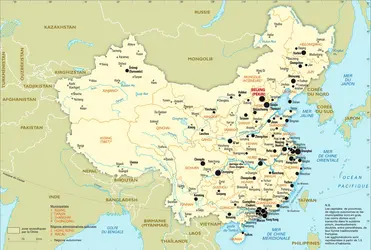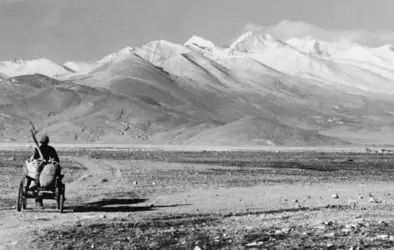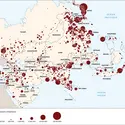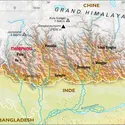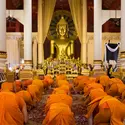TIBET (XIZIANG)
Article modifié le
Bibliographie
Géographie
p. gentelle & p. pelletier dir., Chine, Japon, Corée, Géographie universelle, vol. 5, Belin-Reclus, Paris, 1994
P. Gourou, L'Asie, Hachette, Paris, 1964
s. karmay & p. sagant, Les Habitants du Toit du monde : hommage à Alexander W. MacDonald, Société d'ethnologie, Nanterre, 1997
A. Kolb, East Asia, Londres, 1971
« La Région autonome du Tibet », in Notes et études documentaires, no 3471, Document. franç., Paris, 1968
J. L. Mercier & Li Guangcen dir., Mission franco-chinoise au Tibet 1980, éd. du C.N.R.S., Paris, 1984
f. pommaret et al., Lhasa, lieu du divin : la capitale des dalaï-lamas, Olizane, Genève, 1997
T. Shabad, China's Changing Map, Londres, 1972
Tibet, Environment and Development, Department of Information and International Relations, Dharamsala, 1992.
Histoire
Ouvrages généraux
J. Bacot, Introduction à l'histoire du Tibet, Geuthner, Paris, 1962
P. Blanc, Tibet d'hier et d'aujourd'hui, G. Le Pret, Paris, 1985
c. deweirdt et al., Le Tibet, Peuples du Monde, Paris, 1991
l. deshayes, Histoire du Tibet, Fayard, Paris, 1997
d. snellgrove & h. richardson, A Cultural History of Tibet, Shambala, Boston-Londres, 1986
T. W. D. Shakabpa, Tibet. A Political History, New Haven (Conn.), 1967/ G. Van Grasdorff, La Nouvelle Histoire du Tibet, Perrin, Paris, 2004.
Études sur des périodes particulières
r. barnett, Resistance and Reform in Tibet, Hurst & Co., Londres, 1994 ; Cutting Off the Serpent's Head. Tightening Control in Tibet, 1994-1995, Tibet Information Network and Human Rights Watch, 1996
C. Bell, Portrait of the [XIIIth] Dalaï-Lama, Londres, 1946
P. Demiéville, Le Concile de Lhasa, P.U.F., Paris, 1952
P.-A. Donnet, Tibet mort ou vif, Gallimard, Paris, 1990
E. Haarh, The Yarlung Dynasty, Copenhague, 1969
c. levenson, p. a. donnet, h. stoddard et al., Tibet, l'envers du décor, Olizane, Genève, 1993
C. Levenson, Tibet : la question qui dérange, Albin Michel, Paris, 2008/ Li Tieh-tseng, Tibet Today and Yesterday, New York, 1960
L. Petech, China and Tibet in the Early XVIIIth Century, Leyde, 2e éd. 1972
R. Rahul, The Government and Politics of Tibet, Delhi, 1969
H. E. Richardson, Tibet and its History, Londres, 1962
G. Schulemann, Geschichte der Dalaï-Lamas, Leipzig, 2e éd. 1958
G. Tucci, Tibetan Painted Scrolls, Rome, 1949 ; The Tombs of the Tibetan Kings, Rome, 1950 / A.-M. Blondeau & K. Buffetrille, Le Tibet est-il chinois ?, Albin Michel, Paris, 2002.
Religion et littérature
J. Bacot, Trois Mystères tibétains, Paris, 1921 ; Le Poète tibétain Milarépa, Paris, 1925 ; La Vie de Marpa, le « traducteur », Paris, 1937
A. M. Blondeau, « Les Pèlerinages », in Sources orientales, vol. III, Paris, 1960 ; « Les Religions du Tibet », in Histoire des religions, vol. III, Encyclopédie de la Pléiade, Gallimard, Paris, 1976
W. E. Clark, Two Lamaistic Pantheons, New York, 2e sem. 1965
E. M. Dargyay, The Rise of Esoteric Buddhism in Tibet, Delhi, 1977
A. David-Neel, Textes tibétains inédits, La Colombe, Paris, 1952
P. Demiéville, Le Concile de Lhasa, P.U.F., 1952
A. Getty, The Gods of Northern Buddhism, Oxford, 1928
A. K. Gordon, The Iconography of Tibetan Lamaism, Ruthland-T̄okȳo, 1959
H. V. Guenther, The Jewel Ornament of Liberation, Londres, 1959 ; The Life and Teaching of N̄aroppa, Londres, 1963 ; Buddhist Philosophy in Theory and Practice, Londres, 1972
H. Hoffmann, The Religions of Tibet, Londres, 1961
R.-E. Huc, Souvenirs d'un voyage dans la Tartarie et le Tibet, L.G.E., Paris, 2e éd. 1962
S. G. Karmay, The Treasury of Good Sayings : a Tibetan History of Bon, Londres, 1972
P. Kvaerne, « The Canon of the tibetan bonpos », in Indo-Iranian Journ., vol. XVI, nos 1 et 2, La Haye, 1974
F. Lessing & A. Wayman, Mkhas grub rje's Fundamentals of the Buddhist Tantras, La Haye, 1968
R. de Nebesky-Wojkowitz, Oracles and Demons of Tibet, La Haye, 1956
Nyingma Edition of the sDe-dge bKa-gyur and bsTn-gyur, T._Tulku dir., 120_vol., Dharma Public., Berkeley, 1981_/ E._Obermiller, Nirvana in Tibetan Buddhism, South Asia Books, Columbia (Mo.), 1987
P. Pelliot, Histoire ancienne du Tibet, Maisonneuve, Paris, 1961
F. Pommaret, Les Revenants de l'au-delà dans le monde tibétain, C.N.R.S., Paris, 1989
G. N. Roerich, The Blue Annals of gZhon-nu-dpal, 2 vol., Calcutta, 1949-1953
D. S. Ruegg, La Théorie du Tath̄agathagarbha et du gotra, Maisonneuve, 1969
A. P. Sinnett, Esoteric Buddhism, San Diego, 5e éd. 1987 (Le Bouddhisme ésotérique, Adyar, Paris, 1993)_/ D.\'83L._Snellgrove, The Hevajra Tantra, 2 vol., Londres, 1959 ; Indian Buddhists and their Tibetan Successors, 2 vol., Shambhala Publ., Boston (Mass.), 1987
R. A. Stein, La Civilisation tibétaine, Dunod, Paris, 1962, 2e éd. Le Sycomore, 1981 ; Vie et chants de 'Brug-pa kun-legs le yogin, Maisonneuve et Larose, Paris, 1972
G. C. Toussaint, Le Dict de Padma, Leroux, Paris, 1933
G. Tucci, Théorie et pratique du mandala, Fayard, Paris, 1974
G. Tucci & W. Heissig, Les Religions du Tibet et de la Mongolie, Payot, Paris, 1973
L. A. Waddell, The Buddhism of Tibet : Lamaism, Londres, 1895, rééd. West Orange (N.J.), 1970.
Archéologie et art
G. Béguin, Mandala : diagrammes ésotériques du Népal et du Tibet au musée Guimet, Éd. Findakly, Paris, 1993
L. S. Dagyab, Tibetan Religious Art, 2 parties, O. Harrassowitz dir., Wiesbaden
Demeure des hommes, sanctuaires des dieux, catal. expos., La Sapienza, Rome-Paris, 1987
Dieux et démons de l'Himalaya, catal. expos., Musées nationaux, Paris, 1977
J. C. Huntington, The Styles and Stylistic Sources of Tibetan Paintings, Ph. D, Univ. of Calif., Los Angeles, 1968
D. P. & J. A. Jackson, Tibetan Thangka Painting, Serindia, Londres, 1994
H. Karmay, Early Sino-Tibetan Art, Aris & Philips, Warminster, 1975
W. A. Oddy & W. Zwalf, Aspect of Tibetan Metallurgy, British Museum, Occasional Paper, no 15, 1981
P. Pal, The Art of Tibet, Asia House Gallery, New York, 1969, rééd. Los Angeles, 1983
L. Petech, Central Tibet and the Mongols, I.S.M.E.O., Rome, 1990
N. Rhie & R. Thurman, Wisdom and Compassion, the Sacred Art of Tibet, Abrams, New York, 1991
U. von Schroeder, Indo-Tibetan Bronzes, Visual Dharma Publications, Hong Kong, 1981_/ D.\'83L._Snellgrove & H. E. Richardson, Cultural History of Tibet, Trinity Press, Londres, 1968
G. Tucci, Tibet, Archeologia Mundi, Nagel, Genève, 1973 ; Tibetan Painted Scrolls, 3 vol., La Libreria dello Stato, Rome, 1949 ; Indo-Tibetica, 7 vol., Reale Academia, Rome, 1932-1941 ; The Tombs of the Tibetan Kings, I.S.M.E.O., 1950.
Accédez à l'intégralité de nos articles
- Des contenus variés, complets et fiables
- Accessible sur tous les écrans
- Pas de publicité
Déjà abonné ? Se connecter
Écrit par
- Chantal MASSONAUD : chargée de mission au musée Guimet
- Luciano PETECH : professeur à l'université de Rome
- David SNELLGROVE
:
Fellow of the British Academy - Pierre TROLLIET : professeur des Universités, Institut national des langues et civilisations orientales
- Encyclopædia Universalis : services rédactionnels de l'Encyclopædia Universalis
Classification
Médias
Autres références
-
ASIE (Géographie humaine et régionale) - Espaces et sociétés
- Écrit par Philippe PELLETIER
- 23 143 mots
- 4 médias
...de cette nouvelle situation au cœur de l'Asie, la Chine réalise deux projets majeurs en 2006. D'une part, elle prolonge son réseau ferroviaire jusqu'au Tibet, en ouvrant la voie Golmud-Lhassa (1 100 km), la plus haute du monde (col de Tanggula, 5 072 m), qui lui permettra de renforcer sa mainmise sur... -
BHOUTAN
- Écrit par Benoît CAILMAIL , François DURAND-DASTÈS , Alain LAMBALLE et Chantal MASSONAUD
- 7 363 mots
- 6 médias
...aurait été peuplé au cours du Ier millénaire par des tribus d'origine indo-mongole, confédérées en États princiers, au moment où règne au Tibet le roi Srong-btsan sGam-po. C'est alors que les Tibétains firent leurs premières incursions dans le pays qu'ils nomment Lho-yul (pays du Sud) ou... -
BOUDDHISME (Histoire) - L'expansion
- Écrit par Jean NAUDOU
- 3 118 mots
- 4 médias
La conversion du Tibet au bouddhisme se confond avec l'introduction des civilisations indienne et chinoise, dans ce pays isolé et resté à l'écart des grands courants culturels jusqu'au milieu du viie siècle de notre ère. Le bouddhisme pourtant, d'après la légende, serait apparu au... -
BRAHMAPOUTRE
- Écrit par François DURAND-DASTÈS
- 600 mots
- 1 média
- Afficher les 32 références
Voir aussi
- DIEUX & DÉESSES
- STŪPA
- TANTRA
- AGRAIRES RÉFORMES
- FUNÉRAIRE SCULPTURE
- BRONZE, sculpture
- SOIE PEINTURE SUR
- CONTESTATION
- NÉPAL ARTS DU
- NEWAR ART
- BOUDDHIQUE ART
- DÉCORATION ARCHITECTURALE
- ARISTOCRATIE
- COLLECTIVISATION
- RÉVOLUTION CULTURELLE EN CHINE (1966)
- DOMINATION ÉCONOMIQUE
- TSAPARANG, Tibet
- QUBILAI ou KŪBILĀY ou KUBILAI (1215-1294) grand-khan des Mongols (1260-1294)
- LAMAÏSME
- DZOUNGARS ou DJOUNGARES ou JÜNGAR
- EXTRÊME-ORIENT
- ALTAN-KHAN (1507 env.-1582) souverain mongol (1543-1582)
- DALAÏ-LAMA
- KHOŠŪT ou QOŠŪD ou QOSHOT
- GŪRKHALĪ ou GORKHA
- BOIS, sculpture
- RITES FUNÉRAIRES
- SŪTRA
- VINAYA
- PRAJÑĀPĀRAMITĀ
- PEINTURE MURALE
- REPOUSSÉ TECHNIQUE DU
- MENHIR ou PIERRE DRESSÉE
- TĀRĀ, divinité
- PLAFOND, décoration
- TIBÉTAIN ART
- PARIÉTAL ART
- TARIM BASSIN DU
- TOMBE
- TUMULUS
- TIBÉTAIN, langue
- CHINE, géographie
- TEMPLE, Extrême-Orient
- MANI ou MANÈS (216-273)
- BOUDDHIQUE LITTÉRATURE
- CHINE, histoire : l'Empire, des Qin aux Yuan (1280)
- CHINE, histoire : l'Empire, des Yuan à la Révolution de 1911
- ŚŪNYATĀ ou VACUITÉ
- NGAG-DBANG-BLOB-ZANG-RGYA-MTSHO (1617-1682) Ve Dalai-Lama
- NAM TSO ou TENGRI NOR
- THANG-KA
- TCHAMDO ou CHAMDO
- BON, religion tibétaine
- CHANGTHANG
- RIN-CHEN BZANG-PO (958-1055)
- TSONG-KHA-PA (1357-1419)
- GSHEN-RABS
- RNYING-MA-PA
- SA-SKYA-PA
- MAR-PA (1012-1097)
- KANJUR ou BKA'-'GYUR
- TANJUR ou BSTAN-'GYUR
- ŚĀNTARAKṢITA (VIIIe s.)
- SONGTSEN GAMPO ou SRONG-BTSAN-SGAM-PO (610 env.-649) roi tibétain
- KHRI-SRONG-LDE-BRTSAN, roi du Tibet (755-797)
- 'PHAGS-PA (1235-1280)
- PHAG-MO-GRU-PA, dynastie tibétaine (mil. XIVe s.-mil. XVe s.)
- LAJANG-KHAN (mort en 1717) chef qoshot
- SAMATI PAKSHI (1792-1854)
- THUB-BSTAN RGYA-MTSHO (1876-1933) XIIIe Dalai-Lama
- MGAR (mort en 667)
- PHO-LHA-NAS BSOD-NAMS-STOBS-RGYAS (1689-1747) souverain du Tibet (1727-1747)
- POTALA
- MCHOD-RTEN ou CHORTEN
- GU-GE STYLE DE
- BKA'-BRGYUD-PA
- BU-STON RIN-CHEN GRUB (1290-1364)
- BYANG-CHUB RGYAL-MTSHAN (1302-1373)
- BKA'-BLON
- AMBAN
- BSHAD-SGRA DBANG-PHYUG-RGYAL-PO, bka'-blon et régent tibétain (1862 env.)
- BRONZE ART DU
- COMPOSITION ARCHITECTURALE
- ASIE CENTRALE ART DE L'
- BRITANNIQUE EMPIRE, Asie
- ŚĀKYAMUNI ou ÇĀKYA-MUNI
- BOIS, architecture
- BOUDDHA REPRÉSENTATIONS DU
- KARMA-PA SECTE DES
- RÉINCARNATION
- BOUDDHISME INDIEN
- BOUDDHISME TIBÉTAIN
- CHINE, histoire : de la Révolution de 1911 à la République populaire
- MILITAIRE ARCHITECTURE
- CIVILE ARCHITECTURE
- GÉSAR ou GUÉSAR DE LING
- TECHNIQUES HISTOIRE DES, Antiquité et Moyen Âge
- LHAKHANG, temple
- PHYONG-RGYAS SITE ARCHÉOLOGIQUE DE
- SMAN-RIS ÉCOLE
- MKHYEN-RIS STYLE
- SGA-BRIS STYLE
- INFRASTRUCTURE DE TRANSPORT
- THÉOCRATIE
- POLITIQUE INDUSTRIELLE
- EXTRÊME-ORIENT, architecture
- EXTRÊME-ORIENT, sculpture
- EXTRÊME-ORIENT, peinture
- KARUO SITE PRÉHISTORIQUE DE
- RESSOURCES MINIÈRES
- BKA'-GDAMS-PA ÉCOLE DES
- 'BROG-MI (992-1072)
- MONOLITHES
- SANCTUAIRE
- ARCHITECTURE RELIGIEUSE
- PÉKIN JEUX OLYMPIQUES D'ÉTÉ DE (2008)

